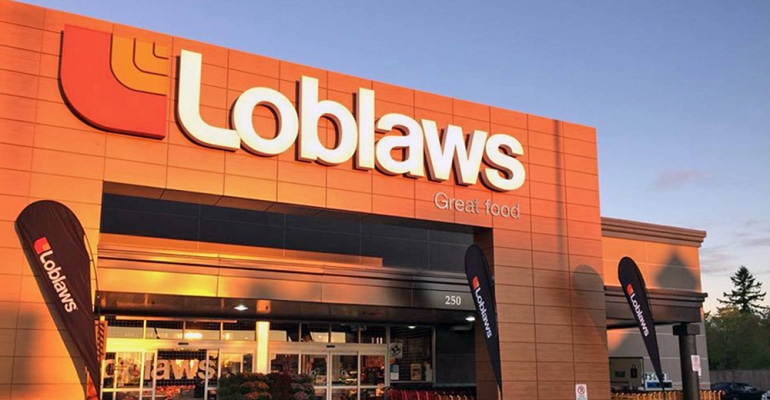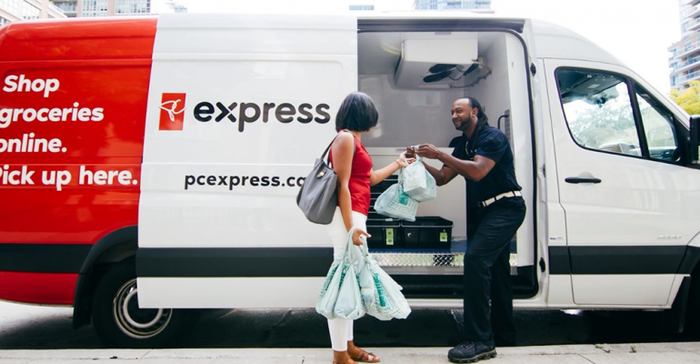Food retail, e-commerce power Loblaw to strong fiscal year finish
Overall online sales jump 160% in Q4 and 178% for full year
February 26, 2021

Loblaw Cos. closed out its 2020 fiscal year on a high note as food retail comparable sales rose nearly 9% and e-commerce sales more than doubled in the fourth quarter.
At the bottom line, Canada’s largest food and drug retailer edged atop analysts’ earnings projection for both the quarter and fiscal year.
For the 13-week fourth quarter ended Jan. 2, retail sales were $13.04 billion (Canadian), up 15.2% from $11.32 billion a year earlier, Loblaw reported yesterday. Excluding the quarter’s extra week versus last year, retail sales rose 7.5% to $12.17 billion, the company said.
Food retail sales climbed 16.9% to $9.3 billion from $7.96 billion. Backing out the quarter’s 13th week, sales were up 8.8% to $8.67 billion. Same-store sales, comparing 12-week quarters, increased 8.6% year over year. Brampton, Ontario-based Loblaw noted that sales continued at elevated levels due to the COVID-19 crisis, with comp sales rising 10.6% in its Market retail division and 7.4% in its Discount retail division. Basket size grew in the quarter, while traffic was down, reflecting a trend across the food retail industry during the pandemic.
Drug retail sales, covering Loblaw’s Shoppers Drug Mart division, advanced 11.3% to $3.74 billion from $3.36 billion, with the gain being 4.3% to $3.51 billion excluding the 13th week. Same-store sales for the 12 weeks rose 3.7%, reflecting upticks of 2.8% in the front end and 5% in the pharmacy. Prescription count increased 9.3% overall and by 1.9% on a comparable-pharmacy basis. Year over year, the average prescription value grew 2%, Loblaw said.
“The fourth quarter represented a continued improvement in our results. Our fourth quarter included an extra week this year. The 53rd [week] came in a little stronger than expected, contributing approximately 10 cents to our fourth-quarter earnings per share,” Chief Financial Officer Darren Myers told analysts yesterday in a conference call.
Food retail sales continued to benefit from strong demand for essential food categories, Myers noted. “Our food retail basket size remained elevated, while traffic continued to show a year-over-year decline in the fourth quarter,” he said. In the drug retail segment, the front-end mix saw a strong performance in convenience categories — including food, household products, and health and beauty aids — while the company “continued to experience pressure” cosmetics and over-the-counter health product sales.
For the 53-week 2020 fiscal year, retail sales totaled $51.86 billion, up 10.1% from $47.1 billion in 2019. The gain was 9.3% excluding franchise consolidation, Loblaw said. Retail sales rose 8.2% to $50.98 billion for the 52-week period. The company didn’t report the 52-week sales breakdowns for food and drug retail.
Food retail sales for the 53 weeks increased 11.3% to $37.6 billion from $33.76 billion, and same-store sales climbed 8.6%. Results reflected strong food and pharmacy sales growth for the period, as well as a bigger basket size and decreased traffic, according to Loblaw.
At the Shoppers Drug Mart drug retail unit, fiscal 2020 sales for the 53 weeks were $14.26 billion, up 6.9% from $13.34 billion a year ago. Comp-store sales rose 4.9%, including increases of 4.5% in the front end and 5.3% in the pharmacy. The number of prescriptions filled rose 6% overall and 4.2% on a same-store basis. Average prescription value gained 0.5%.
“2020 was complicated with many shifting dynamics, but we ended the year having made steady and sequential improvements and entered 2021 with confidence,” Loblaw Cos. President Sarah Ruth Davis (left) said in the call. “Our core business is healthy. We are managing COVID costs, operating well under modified conditions and adapting to pandemic-related pressures on our mix. Most importantly, we are holding onto conventional drug and beauty market share gains earned over the last year and improving our trajectory in discount. The fourth quarter was an illustration of our sequential improvement. Demand for food and drug held our revenue growth high, our retail GP [gross profit] declined, but the trend in the food improved from the prior quarter and operating expense rates improved year over year.”
Davis cited the rebound in the discount food retail division. “It is important to note that our food divisional results were more balanced in Q4 than they have been since the beginning of the pandemic. This suggests discount customers are returning to discount stores following a short pandemic hiatus,” she said.
Meanwhile, Shoppers Drug Mart experienced “some unusual sales results tied to pandemic conditions,” according to Davis. “For example, we’ve largely skipped the flu season, and beauty continues to be affected by lockdowns. These are not long-term concerns. Further, Shoppers is seeing strong results in convenience and food and expanding its role as a health and wellness destination. Our pharmacy services business increased by over 30% in 2020.”
Driven by changing consumer behavior amid the pandemic, e-commerce sales remained strong in the fourth quarter, up 160% year over year. Loblaw finished fiscal 2002 with 178% sales growth in e-commerce.
“For the year, we hit $2.8 billion in online sales, compared to the $1 billion we celebrated a year ago. Online grocery led our digital growth more than tripling to $2 billion, which was rounded out by strong pharmacy, front store, GM and Joe Fresh e-commerce sales,” explained Davis.
“The rise of digital retail has been dramatic. No matter where it settles, we are well-positioned with a scalable national e-commerce platform. We know this is where retail is headed, but it creates a challenge. Online grocery is a higher-cost channel. So we are taking steps to manage margin impacts over the medium term, while maintaining our leadership position.”

Online grocery led Loblaw's e-commerce sales growth, which more than tripled to $2 billion.
On the earnings side, fourth-quarter net income from continuing operations (available to common shareholders) was $354 million, or 98 cents per diluted share, compared with $254 million, or 70 cents per diluted share, a year earlier. Adjusted net earnings from continuing operations (common shareholders) came in at $445 million, or $1.26 per diluted share, versus $395 million, or $70 per diluted share, in the prior-year period.
Full-year 2020 net earnings from continuing operations (common shareholders) totaled $1.1 billion, or $3.06 per diluted share, compared with $1.07 billion, or $2.90 per diluted share, in 2019. On an adjusted basis, net income from continuing operations (common shareholders) was $1.53 billion, or $4.26 per diluted share, versus $1.52 billion, or $4.12 per diluted share, a year ago.
Analysts, on average, had projected Loblaw’s fiscal 2020 adjusted EPS at $1.25 for the fourth quarter and $4.24 for the full year, according to Refinitiv. Estimates ranged from $1.20 to $1.34 for the quarter and $4.13 to $4.34 for the year.
“Looking forward, our outlook is solid,” Loblaw Cos. Chairman and CEO Galen Weston said in the analyst call. “In the near term, we will provide the essentials, vaccinations and support our customers need, whatever COVID may bring. Longer term, as we emerge from this pandemic, Loblaw will be well-positioned with stronger consumer relationships, conviction in our core business and momentum in growth areas that match the lives of Canadians.”
Over the past 12 months, Brampton, Ontario-based Loblaw opened 19 food and drug stores and closed nine locations, resulting in a net gain in total retail square footage of 0.3%. As of the 2020 fiscal year-end, the company’s retail network encompassed 2,439 stores, including 550 corporate-owned supermarkets under multiple banners, 542 franchised grocery stores and 1,347 Shoppers Drug Mart/Pharmaprix associate-owned drugstores.
About the Author
You May Also Like






